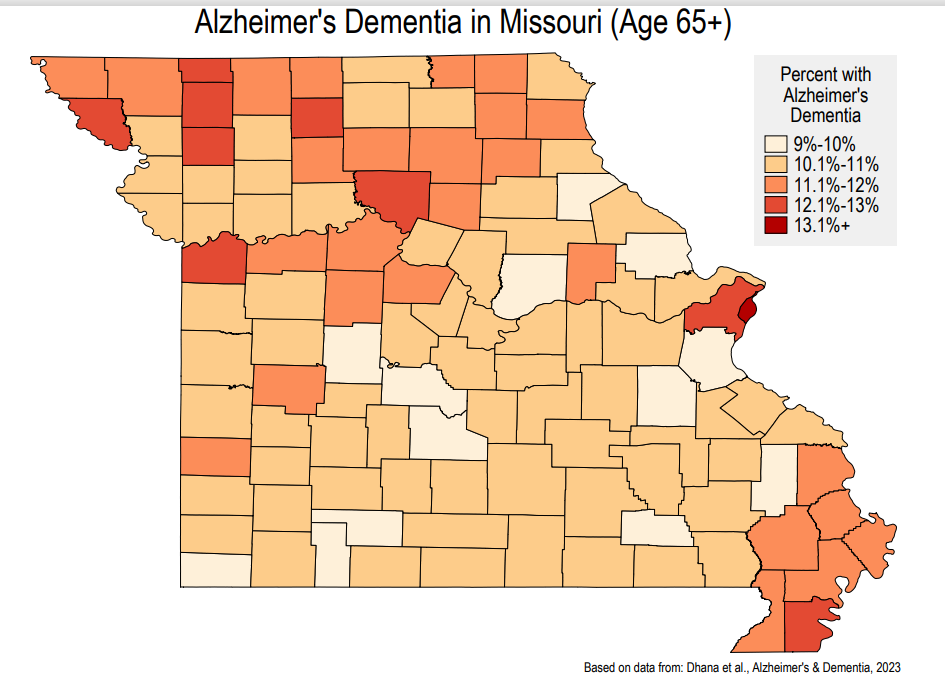County-level Alzheimer's prevalence estimates will help determine where MO needs support
A recent study has given the first-ever county-level estimates of prevalence of people with Alzheimer’s dementia, including in Missouri. The findings were released this past week at the Alzheimer's Association International Conference.
In Greene County, it's estimated that 10.1 to 11% of people over the age of 65 have Alzheimer's. The highest estimate is in Clayton County, where 13.1% or more in that age group have been diagnosed with Alzheimer's.
The Bootheel, in and around St. Louis, and parts of the northern third of the state also have high rates of Alzheimer's.
More: Bolivar man spends 9 hours in 4 cities climbing stairs to raise awareness for Alzheimer's
Sarah Lovegreen, vice president of programs for the Greater Missouri Alzheimer’s Association, said the research can help inform the Missouri Alzheimer's State Plan as well as the Missouri's Master Plan on Aging. In addition, it can also provide insight on where services are most needed.

"Having this type of data really helps us prioritize where we focus those types of efforts, in order to have not only the most impact, but also impact where there's the highest level of need," Lovegreen said.
Dr. Jean Guan, a geriatric medicine specialist with CoxHealth, hopes the data will lead to increased support.
"I wish we had more caregiver support services. I wish we had more dedicated inpatient memory services or respite care services for caregivers but I’m incredibly grateful for the Alzheimer’s Association and their dementia care coordination services because at least it gives the patients something to work with," Guan said.
Guan also added that the increased knowledge and awareness of dementia and Alzheimer's diseases are also key to better outcomes, and encouraged patients not to hesitate to bring up concerns with their doctors.
Nationally, east and southeastern parts of the US see highest prevalence of Alzheimer's
The east and southeastern regions of the United States were found to have the highest prevalence.
The study identified Miami-Dade County, Florida; Bronx County, New York, and Baltimore City, Maryland, as having the highest rates of Alzheimer's in the country. In those counties, 16.6% of adults over 65 had Alzheimer's. The findings noted a combination of specific demographic characteristics that may explain the higher prevalence in those counties, including older average age and higher percentages of Black and Hispanic residents.
Kumar B. Rajan, professor in the department of Internal Medicine at Rush Medical College, and his colleagues used cognitive data from the Chicago Health and Aging Project and population estimates from the National Center for Health Statistics to estimate the prevalence of Alzheimer’s in adults 65 years and older in all U.S. counties.
More: Social media, area organizations help Springfield hospice patient meet Dolly Parton
“These new estimates add more granular data to our understanding of Alzheimer’s prevalence across thecountry,” Rajan said in a press release. “This information, in addition to raising awareness of the Alzheimer’s crisis inspecific communities, may help public health programs better allocate funding, staffing and other resources for caring for people with Alzheimer’s and all other dementia.”
Based on previous projections, the Alzheimer's Association's Facts and Figures report shows the west and southwest regions of the U.S. will experience the largest percentage increase in people living with Alzheimer’s dementia between 2020 and 2025.
“Alzheimer’s prevalence estimates can help federal and state public health officials determine the burden on the health care system, and county-level estimates help us better understand and pinpoint areas of high risk and high need — where, for example, culturally-sensitive health support and caregiver training services are needed,” said Matthew Baumgart, Alzheimer’s Association vice president of health policy. “As the prevalence of Alzheimer’s disease increases, so does the need for a larger workforce that is trained in diagnosing, treating and caring for those living with the disease.”
This article originally appeared on Springfield News-Leader: New Alzheimer's prevalence data shows where Missouri needs support

